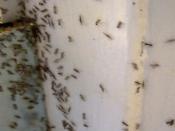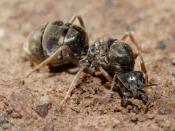Introduction
Myrmecology has been around since the late 18th and early 19th century. Myrmecology is derived from the Greek word Murmek, which means ant. There are three main names that are most noteworthy: Linne who produced "Systemae Naturae" which he describes eighteen species of ants. Fabricius created five more genera and further described other species. Latreille was the most significant, he collected and studied the ants of Europe and described many species overlooked by his predecessors. In 1967 a fossil was found that was preserved in amber fossil which showed an extinct species of an ant dating as far back as the Cretaceous Age, near eighty million years ago (as cited in Ant Nest, 2005).
Methods/Data
The ant farm that was observed was numbered 15. The farm was located in the back of the biology lab room with artificial lighting. The ant farm structure is a clear plastic panel on two sides separated by a very thin space allowing for viewing by the observer, each of the four sides were made of a blue plastic, the inside had a blue fictitious farm looking structure for the convenience of the observer to get into the mental notion of being an "ant farm" creating a false surface and below ground (surface) appearance.
The laboratory room has artificial fluorescent lighting and no windows for natural lighting.
Visual observations without touching the plastic structure of the ant farm are to take place during the normal course of each of the six weeks consecutively that I am to be in the laboratory classroom. There are nine ants within the structure of the ant farm. Data is to be collected using the natural observation scientific method. This data is to be taken in note format and be extruded to this written scientific paper for submission.


